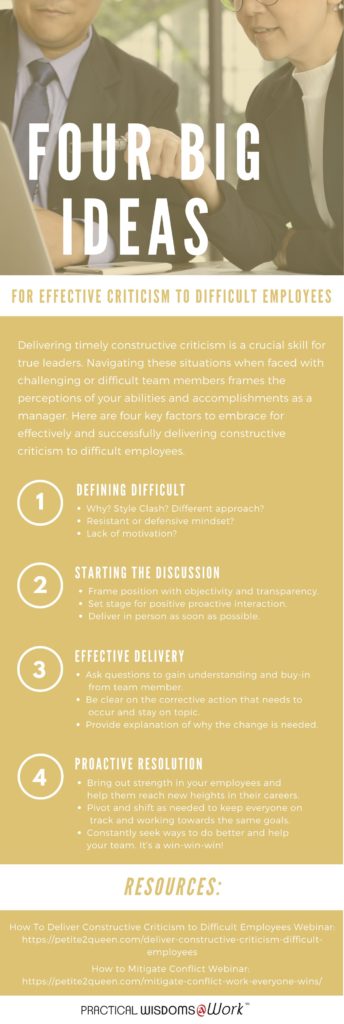We all want to create a workplace culture and environment with the cornerstones of respect and appreciation. Doing so delivers lasting benefits of boosted performance, productivity, and engagement. Building upon this foundation includes actively mentoring, nurturing, adjusting, and critiquing your team for growth.
Delivering timely constructive criticism is a crucial skill for true leaders. Navigating these situations when faced with challenging or difficult team members frames the perceptions of your abilities and accomplishments as a manager. Here are four key factors to embrace for effectively and successfully delivering constructive criticism to difficult employees.
Defining Difficult
1 – Why do you feel the employee is difficult? Is there a personality or style clash? Are your approaches to an opportunity or problem different? Is there something about the employee you simply don’t like?
Start here. Get your head in the game and analyze where you are coming from. Your approach should always begin by seeing the good in the other person. Assume they want to be doing their best at work, in their job, for you, and for the organization.
2 – Is the team member’s mindset resistant to new ideas, defensive to input, or not receptive to change?
Model your approach by asking questions and actively listening to the employee. They may have valid concerns or areas of risk exposure that need to be heard and considered. Understanding the root of resistance is the best method for moving forward and effecting positive change.
3 – Does the employee appear to lack motivation, be sleepwalking through their duties, or exhibiting the vacuity of a zombie?
Are you aware of anything occurring in their personal life that could be affecting them and their performance at work? While you do not want to encroach or delve into an employee’s personal life, there are times of personal crisis that will impact their performance. Compassion and respect builds a bridge to correct performance and get the team member back on track.
Starting the Discussion
- Frame your approach to the discussion from a position of objectivity and a desire for transparency. The demeanor you present will be reflected in your facial expression, body language, and tone as you initiate the discussion. Secure your emotions to ensure you address the behavior or situation, maintaining your focus and actionable process.
- Proper timing sets the stage for a proactive and positive interaction. It creates the opportunity to move forward. While the circumstances may warrant immediate or on-the-fly corrective measures, first secure a private setting. You provide an atmosphere of dignity and respect for your team member, and by doing so, are far more likely to effect a lasting impact.
- Deliver constructive criticism in person, and as soon as possible. Emails and voicemails can easily be misconstrued, are impersonal, and may seem like an afterthought. A virtual video call is an ideal alternative if you cannot have the conversation in person. If an immediate discussion would be disruptive, or a cool down period is needed, set a time for the conversation without delay.
Effective Delivery
- Focus on the “why” and ask questions to gain understanding and buy-in from the team member. To avoid defensive posturing, ask “how” to seek their opinion, or start with, “I have a question for you.” Be genuinely curious and allow the employee time to formulate their thoughts and respond.
- Be clear on the corrective action that needs to occur and stay on topic. Be factual; it’s not personal. It’s about a task, routine, method, or abject item. Speak to their values and the opportunities to push the needle forward.
- Provide an explanation of why the change is needed. Eliminate resistance due to a feeling of an arbitrary preference. Your objective is to establish common ground, collect ideas, and discover best alternatives. Inspire the employee to take ownership and realize the benefits for themselves, the team, and organization.
Proactive Resolution
- The process of delivering constructive criticism is vital for effective management to correct your employees and help them become the best they can be. You are bringing out the strength in your employees, and helping them reach new heights in their careers, while moving the team toward its goals.
- Listen to the concerns and invite input from your team. It’s a prism to see all around an issue. Pivot and shift as needed to keep everyone on track and working towards the same goals.
- Your approach is the guiding force on your team. Constantly seek ways to do better. Helping your team to do so will encourage employees to look for ways to expand their skills and streamline their work, too. It’s a win-win-win!
Giving and receiving healthy criticism is a growth and advancement game-changer for individuals and organizations. It enables you to explore and discover the deeper reasons why, clarifies beliefs and values, and motivates us to intentionally capture and act upon new ideas.
Looking for more tips? Check out our webinar on delivering constructive criticism to difficult employees.

Lynn Whitbeck is the co-founder and President of Petite2Queen. She is focused on identifying and evaluating opportunities for women at work, helping them define their personal roadmap. She dedicates herself to delivering tools and insights, embracing visualization of the big picture, and identifying and implementing the minutiae of detail. Lynn aims to share lessons learned along her journey and enable positive uplift for women.


